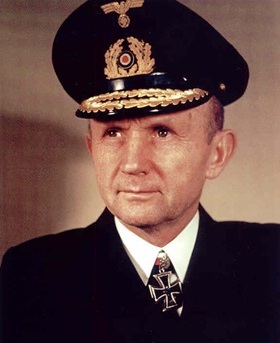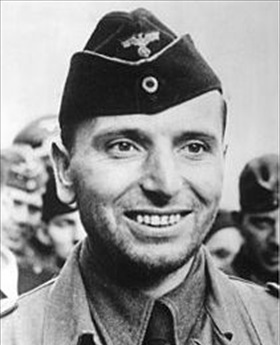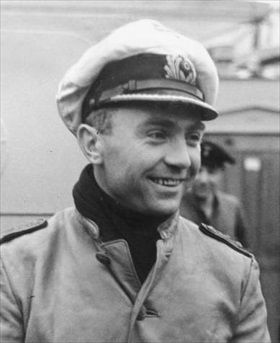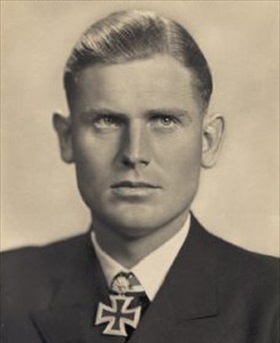U-BOAT SUNK, ACE SKIPPER CAPTURED
Aboard the HMS Walker in the North Atlantic • March 17, 1941
On this date in 1941 U-99, skippered by Otto Kretschmer, one of Germany’s most famous U‑boat commanders, had just fired the last of her torpedoes when she was spotted by a British destroyer southeast of Iceland in the North Atlantic. By this time Kretschmer, on his eighth patrol, had sunk 45 ships for about 270,000 tons and captured one for another 2,000 tons. For his feats the 29‑year-old lieutenant commander had earned the Knight’s Cross of the Iron Cross with Oak Leaves and Swords and the number-one spot on the Aces of the Deep list. (Adolf Hitler personally invited Kretschmer to Berlin for the award ceremony and asked him to stay for lunch.)
Kretschmer’s second watch officer, who was on the bridge that night, immediately ordered the year-old Type VIIB U‑boat to crash dive. But once the boat was beneath the surface, it was quickly fixed on by the early submarine detection system known as ASDIC (later replaced by sonar). Under attack by destroyers HMS Walker and Vanoc, the U‑99 was driven deep (700 ft/213 m) and severely damaged by depth charges that smashed air, fuel, and ballast tanks. Kretschmer had no choice but to blow all ballast tanks and shoot to the surface. Both British destroyers opened fire on the U‑99 with 4 in/102 mm guns, though after 2 minutes neither had found their target. Kretschmer ordered his crew to abandon ship and scuttle the boat, then he dashed off a final radio message to Kriegsmarine Adm. Karl Doenitz at U‑boat headquarters in Kerneval (outside Lorient), occupied France, announcing their capture. Three U‑99 crewmen lost their lives while 40 men, including Kretschmer, were rescued and became POWs.
The capture of Kretschmer and crew came quickly on the heels of 2 U‑boat Ritterkreuz captains lost at sea: Guenther Prien (U‑47) and Joachim Schepke (U‑100), whose naval career was ended by the same 2 British destroyers that ended Kretschmer’s. Kretschmer spent the remainder of the war briefly in Grizedale Hall, Britain’s main POW camp for German officers (nicknamed “U‑boat Hotel” for the number of Kriegsmarine prisoners held there), and then in Canada’s Bowmanville POW camp, a former boys school 40 miles/64 kilometers east of Toronto, Ontario. In September 1943 Canadian military intelligence and police thwarted a German plan to rescue Kretschmer and 3 other high-ranking naval officers from Bowmanville. After the war, Kretschmer joined the West German Navy and in May 1965 became the Chief of Staff of the NATO Command, retiring in 1970 with a rank of Flottillenadmiral (rear admiral).
Grand Admiral Karl Doenitz and Three of His Most Successful U-Boat Skippers
 |  |
Left: Grand Admiral Karl Doenitz (1891–1980). At the start of World War II, Doenitz was the senior submarine officer in the Kriegsmarine (German Navy). In January 1943 he assumed the office of Commander-in-Chief of the Kriegsmarine. After Hitler’s suicide on April 30, 1945, Doenitz succeeded to the highest political office in Nazi Germany, that of Reich President (the office of Fuehrer was abolished upon Hitler’s death). Following his arrest by the Allies on May 25, 1945, Doenitz was indicted as a major war criminal at the postwar Nuremberg Trials and sentenced to 10 years in prison. After his release he settled into retirement outside the port city of Hamburg, writing his memoirs and occasionally giving lectures, but he made no attempt in the new West Germany to serve his country politically or militarily.
![]()
Right: Lieutenant Commander Otto Kretschmer (1912–1998). On his last patrol in March 1941 he sank 10 ships. Following his capture he spent almost 7 years as a POW, first in England, then in Canada. After his release Kretschmer continued his distinguished service in the Bundesmarine.
 |  |
Left: Lieutenant Commander Guenther Prien (1908–1941). First member of the Kriegsmarine to receive the Knight’s Cross of the Iron Cross with Oak Leaves, Germany’s highest military decoration at the time of its presentation to Prien. Under Prien’s command U‑47 sank over 30 Allied ships—8 ships for a total of 51,483 shipping tons in June 1940 alone. Prien’s most famous exploit was to sink the British battleship HMS Royal Oak at anchor in Scapa Flow, Great Britain’s chief naval base in the Orkney Islands far to the north in Scotland, at a cost to the Royal Navy of 1,234 seamen. Scapa Flow controlled the entrances to the North Sea.
![]()
Right: Lieutenant Commander Joachim Schepke (1912–1941). Schepke was the seventh recipient of the Knight’s Cross of the Iron Cross with Oak Leaves. A convinced Nazi, Schepke sank 37 Allied ships and damaged 4 more. After Schepke’s death, Joseph Goebbels’ propaganda ministry held the handsome skipper (nicknamed “Her Majesty’s best-looking officer”) as an example for German youth to follow.
Doenitz’s U-Boats: Their Rise and Demise in the Battle of the Atlantic
![]()

 History buffs, there is good news! The Daily Chronicles of World War II is now available as an ebook for $4.99 on Amazon.com. Containing a year’s worth of dated entries from this website, the ebook brings the story of this tumultuous era to life in a compelling, authoritative, and succinct manner. Featuring inventive navigation aids, the ebook enables readers to instantly move forward or backward by month and date to different dated entries. Simple and elegant! Click
History buffs, there is good news! The Daily Chronicles of World War II is now available as an ebook for $4.99 on Amazon.com. Containing a year’s worth of dated entries from this website, the ebook brings the story of this tumultuous era to life in a compelling, authoritative, and succinct manner. Featuring inventive navigation aids, the ebook enables readers to instantly move forward or backward by month and date to different dated entries. Simple and elegant! Click 











